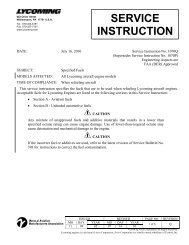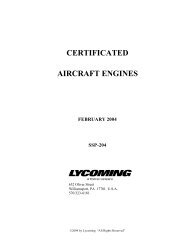You also want an ePaper? Increase the reach of your titles
YUMPU automatically turns print PDFs into web optimized ePapers that Google loves.
If you are not sure of the meaning of such terms as normally<br />
aspirated, turbocharged, supercharged or direct-drive<br />
engines, then perhaps you’ll want to read our simplified definition<br />
of them.<br />
The Normally Aspirated Engine is one that is not turbocharged<br />
or supercharged. If the airplane has a manifold pressure gauge,<br />
at full takeoff power at sea level on a standard day, it would indicate<br />
an MP reading of approximately 29" of Hg. Takeoff power<br />
at 5,000 ft. density altitude airport would read about 24" MP.<br />
The normally aspirated engine uses atmospheric pressure and is<br />
thereby altitude limited.<br />
Direct-Drive Engines are those piston-powered engines where<br />
the propeller is bolted on the end of the crankshaft, and the prop<br />
turns at the same speed as the crankshaft.<br />
Geared Engines are usually the higher powered, more complex<br />
engines using a reduction gear on the nose of the aircraft,<br />
and with the prop attached to it. As a result, the prop will turn<br />
somewhat slower than the crankshaft, resulting in a lower prop<br />
noise level. When the engine is geared, we precede the engine<br />
designation with a “G.” Thus a geared, opposed (O) normally<br />
aspirated <strong>Lycoming</strong> engine with a 480-cubic inch displacement<br />
of the cylinders would be designated a GO-480 model.<br />
Turbocharged Engines as manufactured by <strong>Lycoming</strong> simply<br />
consist of a turbocharger unit with a small turbine wheel attached<br />
by a common shaft to a compressor wheel, and utilizes the engine<br />
exhaust gas by directing it over the turbine wheel to drive the<br />
compressor. The horsepower loss in operating the turbocharger is<br />
negligible. Turbocharging can provide greater utility to the piston<br />
engine by providing sea-level horsepower, in some models, as high<br />
as 20,000 feet; or it can be used to add horsepower to the engine<br />
particularly for takeoffs. The faster the engine runs, the more air<br />
the turbocharger can pack into the cylinder to compensate for the<br />
thin air of altitude, or to increase the horsepower. Although this<br />
definition is somewhat oversimplified, it is a basic definition of<br />
turbocharging of General Aviation power plants.<br />
Where turbocharging is used with a fuel-injected, opposed<br />
<strong>Lycoming</strong> engine with a 540 cubic inch displacement,<br />
we designate it as a TIO-540 model. “T” represents the<br />
turbocharging.<br />
Supercharged Engines as manufactured by <strong>Lycoming</strong> uses a<br />
compressor wheel to pack air into the cylinders; but the compressor<br />
is driven by the crankshaft through an intricate gearing<br />
system, which takes considerable horsepower from the engine to<br />
operate. In comparison with a turbocharged engine, it is a medium<br />
altitude power plant.<br />
Although supercharged engines could be built by <strong>Lycoming</strong>,<br />
new aircraft designs during the past 20 or more years have used<br />
turbocharging instead of supercharging because of the advantages<br />
that turbocharging offers.<br />
A supercharged, geared, opposed, fuel-injected <strong>Lycoming</strong><br />
engine with cylinders of 540-cubic inch displacement is designated<br />
an IGSO-540 model. “S” represents supercharging.<br />
8 L y c o m i n g F l y e r<br />
All publications may be ordered through authorized <strong>Lycoming</strong><br />
distributors, or direct from <strong>Lycoming</strong>. If ordered by mail direct<br />
from <strong>Lycoming</strong>, payment in the form of check or money order<br />
must be submitted with the request as outlined in the latest revision<br />
of <strong>Lycoming</strong> Service Letter No. 114. Fax or telephone orders<br />
will be accepted if payment is made with a credit card: American<br />
Express, Visa and MasterCard are accepted.<br />
The available maintenance publications for <strong>Lycoming</strong> engines<br />
and accessories consist of the following:<br />
OPERATOR’S MANUAL<br />
The Operator’s Manual contains information of use to pilots and<br />
maintenance personnel. It contains engine specifications, inspection<br />
procedures, operational information, and is used in conjunction<br />
with the Pilots Operating Handbook for the aircraft.<br />
OVERHAUL MANUALS<br />
The Overhaul Manual is a guide for major repair of the engine. It<br />
contains complete disassembly, inspection, repair, reassembly and<br />
test procedures for the various <strong>Lycoming</strong> reciprocating engines.<br />
When used in conjunction with the applicable parts catalog and<br />
service bulletins, service instructions and service letters, this<br />
manual provides an authoritative text for complete overhaul of<br />
the engine. Overhaul Manuals for current <strong>Lycoming</strong> engines are<br />
published in loose-leaf format so that revisions may be easily<br />
inserted.<br />
PARTS CATALOGS<br />
<strong>Lycoming</strong> Parts Catalogs are illustrated to permit identification<br />
of parts. A referenced numerical index is also<br />
included.<br />
SERVICE BULLETINS, INSTRUCTIONS, LETTERS<br />
These publications are issued as required. Service Bulletins are<br />
mandatory, and require some modification or inspection to be<br />
accomplished on the engine within a specified time. Service<br />
Instructions cover a variety of subjects; such as repair processes,<br />
modification procedures, inspection procedures and overhaul<br />
methods. Service Letters are of an informative nature, usually<br />
pertaining to service policy or vendor products.<br />
SPECIAL SERVICE PUBLICATIONS<br />
These publications are concerned with topics of general<br />
interest or subjects that are too lengthy for inclusion in maintenance<br />
manuals.<br />
ENGINE SPECIFICATIONS AND INSTALLATION<br />
DRAWINGS<br />
These materials are needed by those who are planning to install<br />
a particular engine model in their aircraft.







